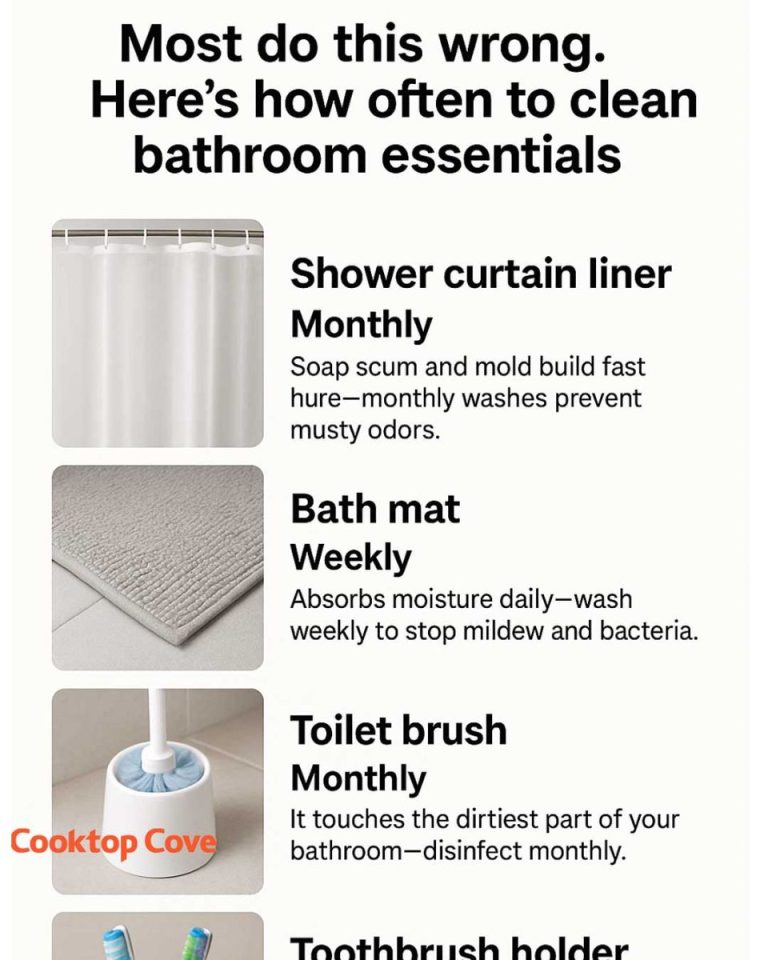ADVERTISEMENT
When it comes to maintaining a clean and hygienic bathroom, many people might not realize how often they should be cleaning various items. While some bathroom essentials are cleaned regularly, others are often overlooked, leading to the accumulation of germs and dirt. Understanding the proper cleaning frequency for each item can help ensure a healthier and more pleasant bathroom environment.
In this article, we will explore the recommended cleaning schedules for common bathroom essentials. By following these guidelines, you can keep your bathroom sparkling clean and free from harmful bacteria. From shower curtains to light fixtures, each item requires specific attention to maintain its cleanliness and functionality.
1. The Importance of Regular Cleaning
Regular cleaning of bathroom essentials is crucial for several reasons. First and foremost, bathrooms are high-traffic areas that are prone to moisture and humidity, creating an ideal environment for bacteria and mold to thrive. Without regular cleaning, these microorganisms can accumulate, leading to unpleasant odors and potential health risks.
Moreover, maintaining a regular cleaning schedule helps prolong the life of bathroom fixtures and accessories. For instance, soap scum and hard water stains can damage surfaces over time if not addressed promptly. By cleaning regularly, you not only ensure a hygienic environment but also protect your investments in bathroom decor and fixtures.
2. Shower Curtain Liner – Monthly
Shower curtain liners are often exposed to water and soap, making them susceptible to mold and mildew growth. To prevent this, it’s recommended to clean your shower curtain liner once a month. You can do this by removing the liner and washing it in a washing machine with warm water and a mild detergent. Adding a cup of white vinegar can help eliminate mold spores and soap scum.
After washing, hang the liner back up to dry completely. This not only keeps the liner fresh but also extends its lifespan. If you notice any stubborn stains or mold that doesn’t come off, it might be time to replace the liner altogether.
3. Bath Mat – Weekly
Bath mats are another bathroom essential that require regular cleaning due to their constant exposure to moisture. It’s advisable to wash bath mats weekly to prevent the buildup of bacteria and mold. Most bath mats can be machine washed using warm water and a mild detergent. For added freshness, consider adding a half cup of baking soda to the wash cycle.
After washing, ensure the bath mat is thoroughly dried before placing it back on the floor. This prevents moisture from being trapped, which can lead to unpleasant odors and mold growth. If your bath mat is made of a delicate material, check the care instructions to ensure proper cleaning.
4. Toilet Brush – Monthly
The toilet brush is an essential tool for maintaining a clean toilet, but it also needs regular cleaning itself. Once a month, soak the toilet brush in a solution of hot water and bleach for about an hour. This helps kill any bacteria and germs that may be lingering on the bristles.
After soaking, rinse the brush thoroughly with hot water and allow it to dry completely before placing it back in its holder. It’s also a good idea to clean the brush holder during this process, as it can harbor bacteria as well.
5. Toothbrush Holder – Weekly
Toothbrush holders are often overlooked when it comes to bathroom cleaning, yet they can harbor a surprising amount of bacteria. It’s recommended to clean your toothbrush holder weekly. You can do this by soaking it in a solution of hot water and dish soap, then scrubbing it with a brush to remove any residue.
Rinse the holder thoroughly and let it air dry before placing your toothbrushes back in. Regular cleaning prevents the buildup of toothpaste residue and bacteria, ensuring a hygienic environment for your oral care tools.
6. Towels – Every Three Uses
Towels are used frequently and can quickly become breeding grounds for bacteria if not washed regularly. It’s advisable to wash bath towels after every three uses. Use hot water and a quality detergent to ensure all bacteria are eliminated.
Additionally, avoid leaving damp towels in a pile, as this encourages bacterial growth. Instead, hang them up to dry completely between uses. For added freshness, consider using a fabric softener or dryer sheets during the drying cycle.
ADVERTISEMENT
